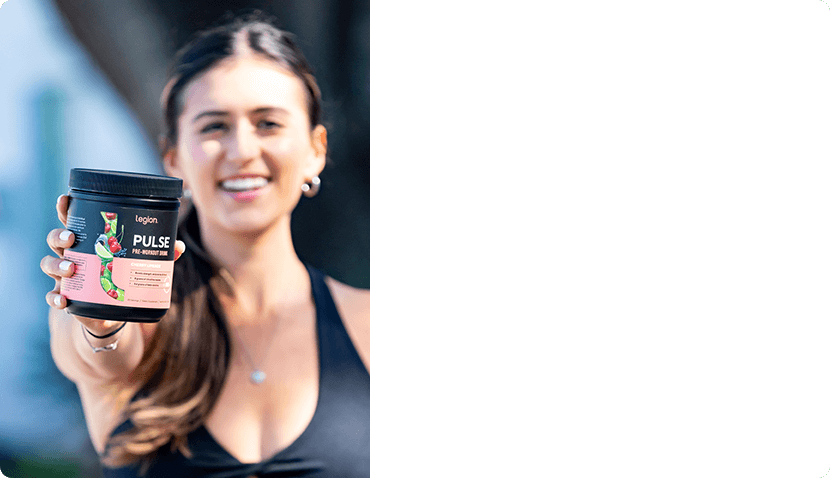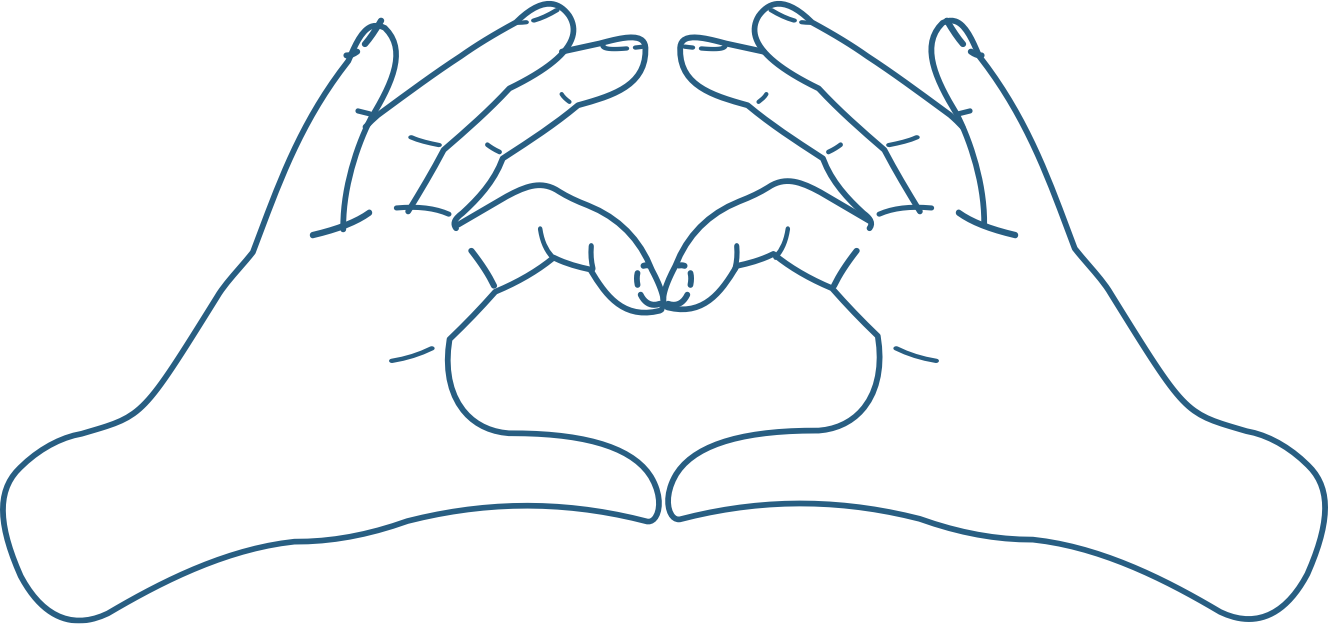Back workouts for mass are more important than many weightlifters realize.
A thick, wide back is crucial for an impressive physique. But more than that, it’s the foundation for your overall performance.
It helps you do pretty much any athletic movement, including squatting, pulling, and pressing more effectively and safely.
In this article, you’ll find a detailed guide to the back’s anatomy, the best exercises for each muscle group in your back, and a routine designed to help you develop a big, muscular back that allows you to perform at your best.
Key Takeaways
- To build proportional back mass, your back routine must include exercises for training your upper, mid, and lower back.
- The best back workout programs prioritize compound exercises like deadlifts, pull-ups, rows, and pullovers, which let you lift heavy, train multiple muscles at once, and progress consistently.
- For the best results in your back workouts for mass, train close to failure and increase the weight once you hit the top of your rep range.
Table of Contents
+
Back Anatomy
The bulk of your back mass comes from the following muscles:
- Trapezius (traps)
- Rhomboids
- Latissimus dorsi (lats)
- Erector spinae
- Posterior deltoids (rear delts)
Smaller muscles like the infraspinatus and teres major and minor contribute less to overall size, though they’re still important for well-rounded back development.
Here’s how all these muscles look on your body:
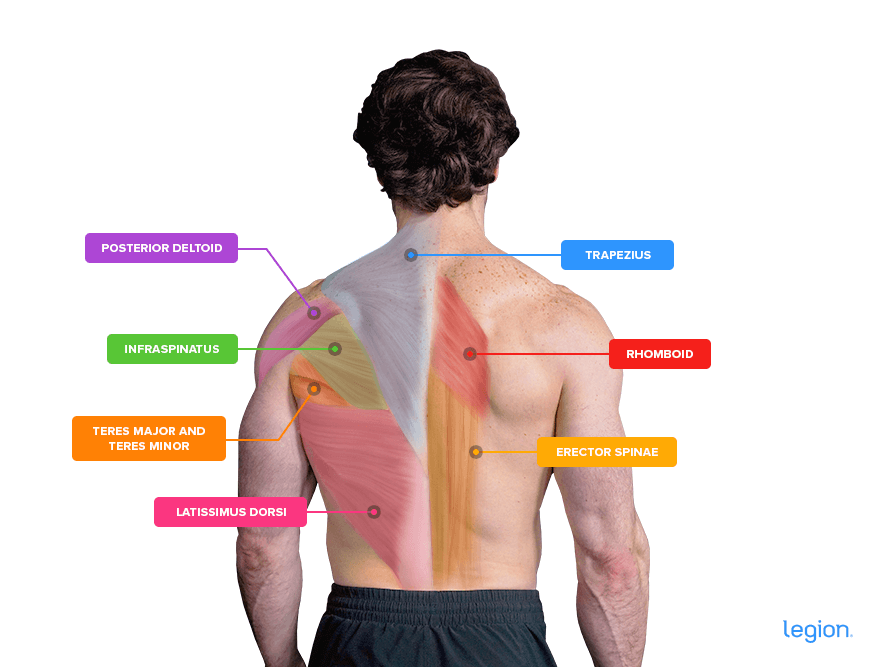
How to Gain Mass and Strength in Your Entire Back
To build a strong, proportional back that looks impressive and supports peak performance, you need to:
- Train every muscle on the back of your torso.
- Focus on compound exercises (exercises that train multiple muscle groups simultaneously).
To achieve the first, divide your back muscles into three areas: Upper, mid, and lower back. Making this distinction ensures you pick exercises that target each section of your back and prevents you from overemphasizing one area.
Here are the muscles in each group:
- Upper Back: Upper traps, rhomboids, teres major and minor, rear delts, and infraspinatus
- Mid Back: Mid and lower traps and lats
- Lower Back: Erector spinae
Focusing on compound exercises is paramount because they allow you to train multiple muscles simultaneously, lift heavy weights safely, and progress regularly, which typically stimulates more overall muscle growth than focusing on isolation exercises (which train one muscle at a time).
The best compound upper back exercises typically involve pulling a weight toward your torso from in front of you, including the barbell, dumbbell, and cable row.
Effective mid back exercises usually involve pulling a weight from above your head toward your torso, such as the pull-up, chin-up, and lat pulldown.
To train your lower back, exercises that involve pulling a weight from the floor (or near to the floor) until you’re standing upright are usually best. Some top-tier examples include the conventional, sumo, and trap-bar deadlift.
The Best Back Workout for Mass and Strength
The following back workout program for mass includes exercises that train your back from top to bottom, so you develop all-around size and strength.
It also contains the perfect amount of volume (sets) to spur growth without wearing your to a frazzle.
If I could only recommend one workout for a massive back, this would be it:
- Deadlift: 3 sets | 4-to-6 reps | 3-to-5 min rest
- Pull-up: 3 sets | 4-to-6 reps | 3-to-5 min rest
- One-Arm Dumbbell Row: 3 sets | 6-to-8 reps | 2-to-3 min rest
- Cable Pullover: 3 sets | 6-to-8 reps | 2-to-3 min rest
Now let’s look at how to perform the exercises and what makes each so effective:
1. Deadlift
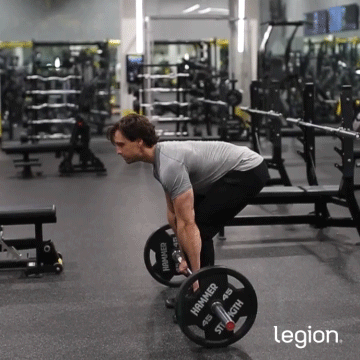
Most of the best back workout routines for mass start with the deadlift because it allows you to lift maximally heavy weights and progressively overload your entire back, so it’s perfect for building back size. It also improves athletic performance and mimics everyday movements, strengthening the muscles involved and making daily tasks easier.
How to:
- Position your feet so they’re a bit less than shoulder-width apart with your toes pointed slightly out. Move a loaded barbell over your midfoot so it’s about an inch from your shins.
- Move down toward the bar by pushing your hips back and grip the bar just outside your shins.
- Take a deep breath of air into your belly, flatten your back by pushing your hips up slightly, and then drive your body upward and slightly back by pushing through your heels until you’re standing up straight.
- Reverse the movement and return to the starting position.
Expert Tip: Pressing your upper arms into your sides as if you were trying to crush oranges in your armpits ensures your shoulders are in the correct starting position and prevents your upper back from rounding, which helps you lift heavier weights more safely.
2. Pull-up
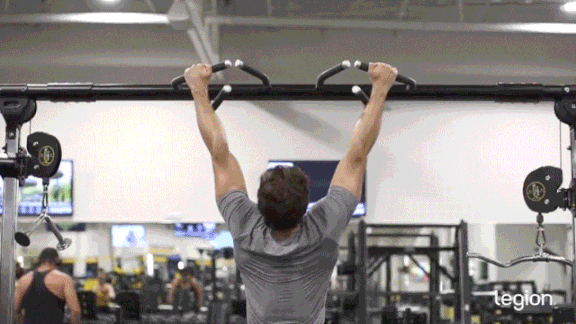
The pull-up is another excellent addition to a hypertrophy back workout. While it trains most back muscles, it’s particularly effective for training your lats, which is important for developing an aesthetic “V-taper” many people want.
How to:
- Grab a pull-up bar slightly wider than shoulder-width apart with your palms facing away from you.
- Lift your feet so that you’re hanging with your arms straight.
- Pull your body up until your chin is above the bar.
- Once your chin has passed the bar, reverse the movement and return to the starting position.
Expert Tip: Pulling yourself up with enough force to “smash” your chest into the bar helps you attack each rep with the intensity you need to get your chin over the bar.
3. One-Arm Dumbbell Row
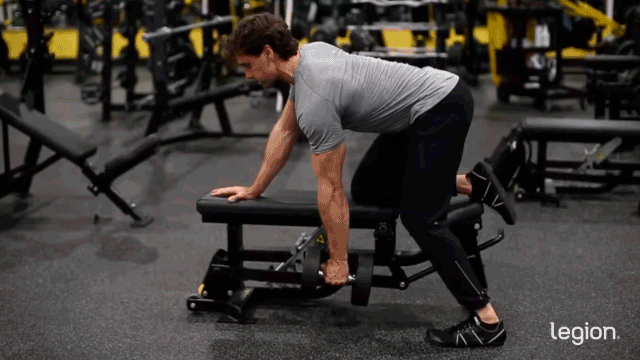
The one-arm dumbbell row trains each side of your back independently, helping you build proportional back mass. It can also help you establish a stronger “mind-muscle connection” and may enhance athletic performance more than back exercises that train both sides of your body simultaneously.
How to:
- Hold a dumbbell in your right hand.
- Plant your left knee and hand firmly on a bench, your right foot on the floor a foot or two from the bench, and let your right arm hang straight down toward the floor.
- Keeping your back straight, pull the dumbbell upward until it touches your torso, and then return the dumbbell to the starting position.
- Once you’ve completed the desired number of reps, repeat the process with your left arm.
Expert Tip: The one-arm dumbbell row has an unusual resistance curve that makes it hard to finish reps, causing you to end your sets before your back is fully stimulated. To fix this, use a bit of momentum to get through the toughest portion of each rep—the top. This allows you to use a full range of motion and perform more total reps per set, leading to greater muscle and strength gains over time.
4. Cable Pullover
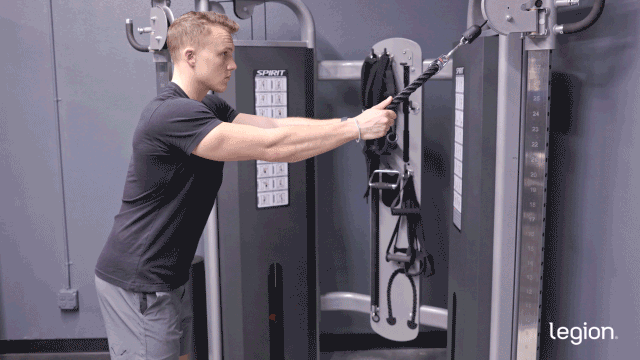
The cable pullover trains your lats in a fully stretched position and through a long range of motion, which makes it highly effective for gaining lat mass.
How to:
- Set the pulley to the highest position on a cable machine and attach the rope handle.
- Hold one end of the rope in each hand, and step away from the pulley until you feel tension in the cable.
- Lean forward until your body makes a 45-degree angle with the floor and your arms are nearly straight overhead.
- Set your feet shoulder-width apart and bend your knees a little.
- Keep a small bend in your elbows and pull the rope in an arc toward your feet until your hands are by your thighs or a little past them.
- Reverse the movement and return to the starting position.
Expert Tip: As the weight pulls your arms upward, lean slightly forward to fully stretch your lats. Then, lean slightly backward as you pull the weight down to fully contract them.
How to Organize Your Back Workout Schedule
If you’re new to weightlifting, doing the back workout above once per week is ideal for gaining size and strength.
If you’ve been training for over a year, doing two back workouts weekly can yield better results.
In this scenario, make the workout above your main back day, and then include some extra back volume in another workout later in the week.
For example, do the back day workout above on Tuesday, then add 3-to-5 sets of pull-ups or rows to the beginning of an upper-body, pull, or arm day on Thursday or Friday.
3 Tips to Get More Out of Your Back Workout Program for Mass
1. End every set 1-to-3 reps shy of muscle failure.
As I explain in my fitness books for men and women, to maximize your gains, you must take most of the sets in your back day workouts to within a rep or two of failure.
Ask yourself at the end of each set, “If I had to, how many more reps could I have gotten with good form?” If the answer is more than two, increase the weight or reps to make your next set more challenging.
2. Once you hit the top of your rep range for a set, move up in weight.
If your back day workout calls for 4-to-6 reps of the deadlift and you get 6 reps for a set, add 10 pounds to your next set.
If you manage 3 or fewer reps with the new weight, reduce the weight by 5 pounds to ensure you stay in the 4-to-6 rep range.
Follow this pattern of trying to add reps or weight to every exercise in every workout, and you’ll have no issues adding mass to your back.
3. Take the right supplements.
These supplements can help you optimize your performance and gains while following your mass-building back workout program:
- Protein powder: Protein powder, such as whey or casein, provides your body with the nutrients needed to build muscle tissue and recover from workouts.
- Creatine: Creatine boosts muscle and strength gain, improves anaerobic endurance, and reduces muscle damage and soreness from your workouts.
- Pre-workout: A high-quality pre-workout enhances energy, mood, and focus, increases strength and endurance, and reduces fatigue.
(If you’d like even more specific advice about which supplements you should take to reach your health and fitness goals, take the Legion Supplement Finder Quiz, and in less than a minute, you’ll know exactly what supplements are right for you.)
FAQ #1: Is deadlifting a back workout?
Yes, the deadlift trains all the muscles on the back side of your body, including your back muscles. It’s most effective for developing the erector spinae, the muscles that run from your skull to your pelvis, adding thickness along your spine. It also does an excellent job of developing the traps, which add mass to your upper back.
READ MORE: What Muscles Do Deadlifts Work? An Answer, According to Science
FAQ #2: Do push-ups work out your back?
Not really. While push-ups engage several back muscles, including the lats, rhomboids, traps, rear delts, and erector spinae, they mainly act as stabilizers and don’t get enough stimulus to grow.
READ MORE: How to Do the Push-up: Form, Variations, and Workouts
FAQ #3: How do you work out your back at home?
The best way to train your back at home is to follow a dumbbell version of the workout routine above, which means investing in a pair of dumbbells.
If that’s not an option, focus on pull-ups, chin-ups, and bodyweight rows. To perform the pull-up and chin-up, you’ll need something sturdy that you can hold and hang from 2-to-3 feet above your head, such as a tree branch, attic rafter, or porch roof.
For bodyweight rows, lie under a strong table, grip the edge with your fingertips, and pull yourself upward.
READ MORE: The 3 Best Back Workout Routines You Can Do at Home
Scientific References +
- Nigro, Federico, and Sandro Bartolomei. “A Comparison between the Squat and the Deadlift for Lower Body Strength and Power Training.” Journal of Human Kinetics, vol. 73, no. 1, 21 July 2020, pp. 145–152, https://doi.org/10.2478/hukin-2019-0139.
- Youdas, James W, et al. “Surface Electromyographic Activation Patterns and Elbow Joint Motion during a Pull-Up, Chin-Up, or Perfect-PullupTM Rotational Exercise.” Journal of Strength and Conditioning Research, vol. 24, no. 12, Dec. 2010, pp. 3404–3414, https://doi.org/10.1519/jsc.0b013e3181f1598c.
- Liao, Kai-Fang , et al. Review Paper Effects of Unilateral vs. Bilateral Resistance Training Interventions on Measures of Strength, Jump, Linear and Change of Direction Speed: A Systematic Review and Meta-Analysis. Mar. 2022, p. Biol Sport. 2022;39(3):485–497, https://doi.org/10.5114/biolsport.2022.107024.
- Park, Se-yeon, and Won-gyu Yoo. “Differential Activation of Parts of the Latissimus Dorsi with Various Isometric Shoulder Exercises.” Journal of Electromyography and Kinesiology, vol. 24, no. 2, Apr. 2014, pp. 253–257, https://doi.org/10.1016/j.jelekin.2013.12.004.
- Gerling, Michael E., and Stephen H. M. Brown. “Architectural Analysis and Predicted Functional Capability of the Human Latissimus Dorsi Muscle.” Journal of Anatomy, vol. 223, no. 2, 13 June 2013, pp. 112–122, https://doi.org/10.1111/joa.12074.
- Schoenfeld, Brad J, and Jozo Grgic. “Effects of Range of Motion on Muscle Development during Resistance Training Interventions: A Systematic Review.” SAGE Open Medicine, vol. 8, no. 8, Jan. 2020, p. 205031212090155, https://doi.org/10.1177/2050312120901559.
- Oranchuk, Dustin J., et al. “Isometric Training and Long-Term Adaptations: Effects of Muscle Length, Intensity, and Intent: A Systematic Review.” Scandinavian Journal of Medicine & Science in Sports, vol. 29, no. 4, 13 Jan. 2019, pp. 484–503, onlinelibrary.wiley.com/doi/full/10.1111/sms.13375, https://doi.org/10.1111/sms.13375.
- Stokes, Tanner, et al. “Recent Perspectives Regarding the Role of Dietary Protein for the Promotion of Muscle Hypertrophy with Resistance Exercise Training.” Nutrients, vol. 10, no. 2, 7 Feb. 2018, p. 180, www.mdpi.com/2072-6643/10/2/180/pdf.
- Eckerson, Joan M., et al. “Effect of Creatine Phosphate Supplementation on Anaerobic Working Capacity and Body Weight after Two and Six Days of Loading in Men and Women.” The Journal of Strength and Conditioning Research, vol. 19, no. 4, 2005, p. 756, https://doi.org/10.1519/r-16924.1.
- Bassit, Reinaldo Abunasser, et al. “Effect of Short-Term Creatine Supplementation on Markers of Skeletal Muscle Damage after Strenuous Contractile Activity.” European Journal of Applied Physiology, vol. 108, no. 5, 3 Dec. 2009, pp. 945–955, https://doi.org/10.1007/s00421-009-1305-1.

